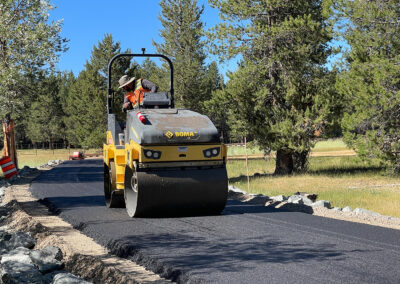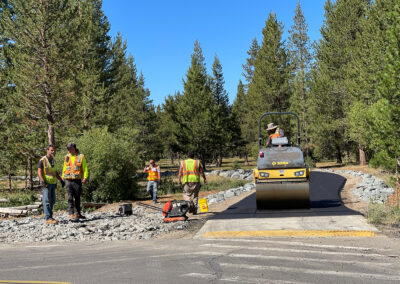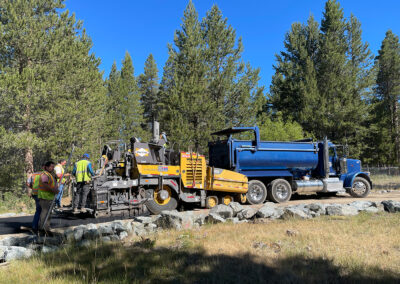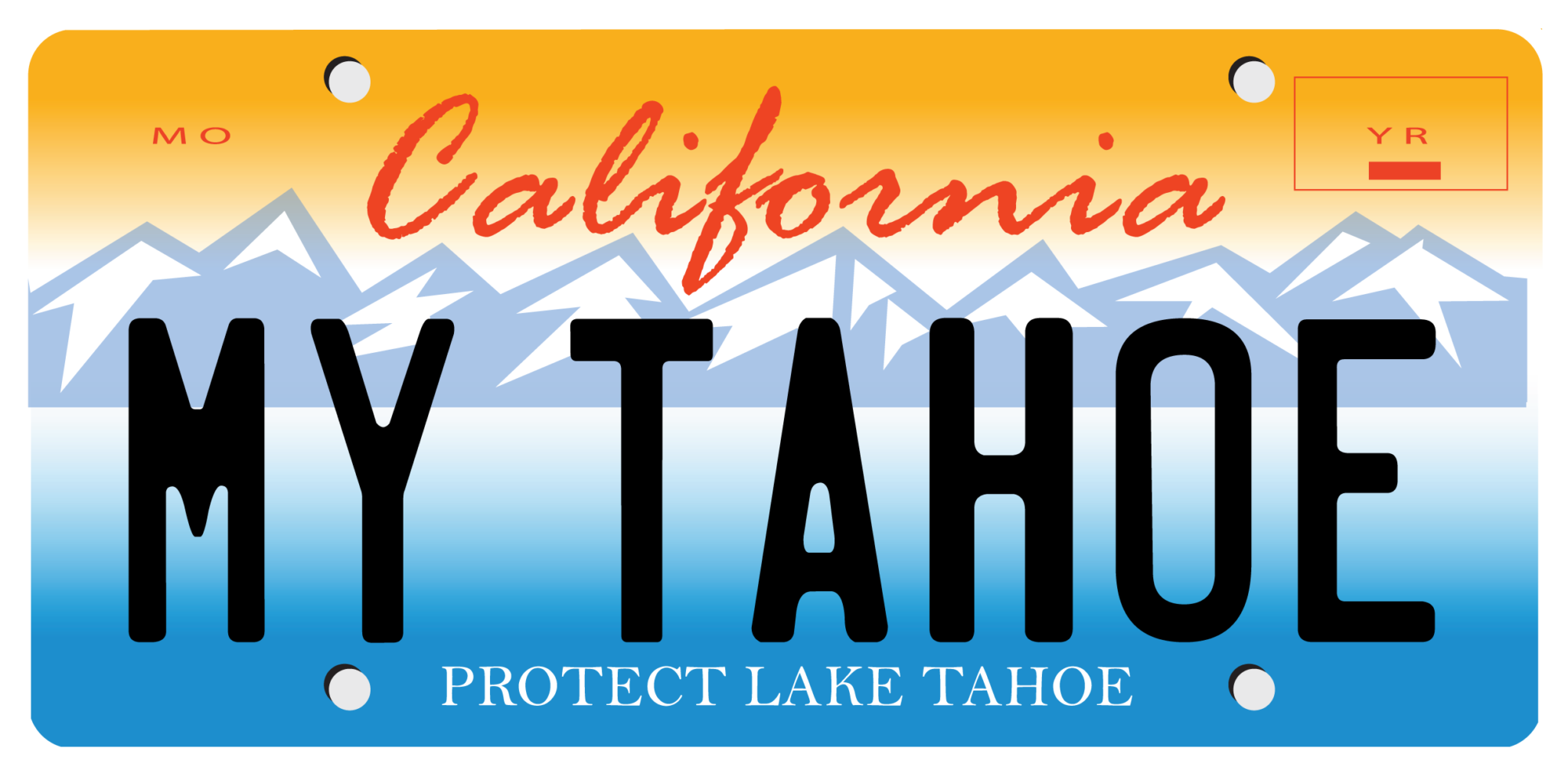
August 2021 Conservancy Newsletter
Wildfire Near Lake Tahoe Shows We Must Adapt How We Care for Our Lands — and Quickly
Fire officials recently allowed my family to return to our home in Markleeville in Alpine County following evacuation for the Tamarack Fire. The fire, started by lightning on July 4, blew up quickly on July 16. Residents and emergency personnel had very little time to react. While there are questions about the decision to let the fire burn rather than to immediately extinguish it, there also are important lessons for the Lake Tahoe Basin and the rest of California.
Lake Tahoe is a national treasure that welcomes three times as many annual visitors as Yosemite. Yet with its risk of wildfire, millions of visitors, 65,000 residents, and abundant public lands, the basin is a microcosm of California. The California Tahoe Conservancy, a state agency, and its partners are actively using the best science, technology, and data to help us identify new and creative solutions to climate-related threats, including wildfire, while balancing this with expediency.
Of course, all of this takes resources.
 In 2019, the Tahoe Fire and Fuels Team―a collaborative group of more than 20 fire protection agencies, land managers, and the Washoe Tribe―identified that the full cost to protect communities and restore forestland throughout the basin would run more than $20 million per year.
In 2019, the Tahoe Fire and Fuels Team―a collaborative group of more than 20 fire protection agencies, land managers, and the Washoe Tribe―identified that the full cost to protect communities and restore forestland throughout the basin would run more than $20 million per year.
Earlier this year, the Legislature and Gov. Gavin Newsom’s administration approved $1 million in early-action funding for the Conservancy. These critical funds enabled us to increase the number of seasonal fire crews who are out removing flammable brush and small trees from overly dense forest on our lands this summer. But the need to protect Tahoe forests and communities remains great.
The Legislature and Newsom administration remain in budget negotiations that are expected to continue through the end of the legislative session in September. The governor has proposed spending another $11 million to further reduce hazardous fuels on thousands of Conservancy-owned lots, most of which sit within residential neighborhoods. This would dramatically increase protections for our neighbors. Yet even that does not meet the needs identified by our fire agencies and fellow land managers.
 The Conservancy, with our partners, recently released a Climate Adaptation Primer, which describes anticipated impacts of climate change on Tahoe communities and natural resources. Included is earlier snow melt, less snow and more rain, hotter temperatures, and larger, more intense wildfires. Unfortunately, Tahoe communities and the world are seeing these types of changes much sooner than predicted.
The Conservancy, with our partners, recently released a Climate Adaptation Primer, which describes anticipated impacts of climate change on Tahoe communities and natural resources. Included is earlier snow melt, less snow and more rain, hotter temperatures, and larger, more intense wildfires. Unfortunately, Tahoe communities and the world are seeing these types of changes much sooner than predicted.
Tahoe had record-breaking temperatures at the time the Tamarack Fire started. And these higher temperatures are not only causing drier, more flammable vegetation. Scientists continue to see threats to the lake’s clarity and ecosystem.
With these changes happening now and into the future, we as land managers are adapting how we manage the land under our care.
In the case of wildfires, this means considering drought, temperature, wind, proximity of communities, and local experience when making decisions about whether to use fire as a management tool. And it means getting ahead of the next fire by aggressively treating our land to thin overly dense forest to reduce wildfire risk. I saw firsthand how clearing trees and brush from around my house, coupled with thinning trees and brush along the perimeter of the community, made the difference for state and local firefighters to protect homes in the fire’s path.
We remain hopeful for funding―including for grants our agency could provide to our regional partners―to reduce wildfire risk for Tahoe communities. This work would protect Tahoe’s $3 billion tourism economy and truly set the basin on a path to resilience so that future generations can continue to enjoy all that Lake Tahoe has to offer.
Jane Freeman
Acting Executive Director, California Tahoe Conservancy
Improving Forest Health & Reducing Wildfire Risk at Van Sickle Bi-State Park
Watch our new video to learn how the Conservancy has collaborated with the Tahoe Douglas Fire Protection District to improve forest resilience and reduce wildfire risk to communities at Van Sickle Bi-State Park, one of Lake Tahoe’s most visited outdoor destinations.
Say, What Are They Building at Lake Tahoe?
Any recent visitor to the Upper Truckee Marsh has seen some rather large construction equipment on the prowl. Some visitors have even asked if someone is building condos at the lakefront Conservancy property. Watch our new video, then visit our Upper Truckee Marsh Restoration Project web page to learn more about the largest wetland restoration in Tahoe’s history.

Conservancy Doubles Preparation for Future Fuel Reduction Projects
Early budget action by the Governor and Legislature enabled the Conservancy to hire more seasonal forestry aides. Residents of neighborhoods along North Upper Truckee Road in El Dorado County may have seen them busy marking forested Conservancy lots. Their work will help prepare future fuels reduction and forest health projects to protect these neighborhoods.

Work Progresses on South Tahoe Greenway
El Dorado County is making rapid progress this summer as they finish up construction of the South Tahoe Greenway, Phases 1b and 2. This shared-use trail will provide a critical link among south shore neighborhoods, Lake Tahoe Community College, and the greater bike trail network.

Improving Forest Health, Reducing Hazardous Fuels on Conservancy Lands in South Lake Tahoe
The Conservancy is grateful to be collaborating with the California Conservation Corps to thin forested Conservancy lots in the Ski Run/Bijou area of South Lake Tahoe. Their work will reduce hazardous fuels on 51 acres of Conservancy lands, improving forest health and reducing wildfire risk to neighbors.
Conservancy Staff Updates
New Employees

Leah Armer
Forestry Aide
Leah joined the Conservancy as a seasonal Forestry Aide in May. She works on fuel hazard reduction projects on Conservancy lands, primarily identifying project boundaries and marking trees for removal. Leah recently served as an Off-Highway Vehicle Forestry Technician with the USDA Forest Service and as a trails crew member for American Conservation Experience. Leah has a Bachelor of Arts from the University of California, Santa Barbara and recently earned her Emergency Medical Technician credentials.

Grant Coleman
Forestry Aide
Grant joined the Conservancy as a seasonal Forestry Aide in May. He works on fuel hazard reduction projects on Conservancy lands, primarily identifying project boundaries and marking trees for removal. Grant previously worked for California State Parks in the Channel Coast District as an Environmental Services Intern where he worked on projects to restore native dunes, monitor snowy plovers and least terns, reduce fuel hazards, and manage invasive plants. He earned his degree in wildlife management and conservation from Humboldt State University.

Angeline Green
Legal Intern
Angeline joined the Conservancy in June as a summer legal intern. She is assisting the Conservancy’s legal department with a variety of California Environmental Quality Act and land use issues involving Conservancy property. A rising third year student at Suffolk University Law School, Angeline has previously served as an AmeriCorps VISTA establishing community volunteer programs to serve low-income schools in southern Massachusetts. She earned a bachelor’s degree in Natural Resources Conservation with a focus in Park and Recreation Management from Virginia Tech.

Daniel Salgado
Forestry Aide
Daniel joined the Conservancy as a seasonal Forestry Aide in May. He works on fuel hazard reduction projects on Conservancy lands, primarily identifying project boundaries and marking trees for removal. work as a forestry aide for the Conservancy. Previously, Daniel served with the California Conservation Corps as a crew leader, working on a variety of projects including fuel reduction, erosion control, and trail maintenance. He is currently studying for an environmental science degree at Lake Tahoe Community College and in the future plans to study towards his forestry degree.

Kyle Schnapp
Forestry Aide
Kyle joined the conservancy as a seasonal Forestry Aide in May. He previously served on a forestry crew at the Great Basin institute on projects improving sage grouse habitat. Kyle has also conducted insect surveys for the Nevada Department of Agriculture. He earned his Associate in Science degree in Natural Sciences at Sierra College and his Bachelor of Science in Environmental Science from the University of Nevada, Reno, with a specialization in ecological conservation and restoration.
Upcoming California Tahoe Conservancy Board Meetings
The California Tahoe Conservancy Board will meet on September 16, 2021. An agenda will be available on the Conservancy website ten days prior to the meeting.
Lake Tahoe in the News
Tahoe Conservancy trying to keep up with fire fuel reductions – Tahoe Daily Tribune, July 27, 2021
Tahoe’s natural filters: Preserving, restoring wetlands essential to lake clarity – Tahoe Daily Tribune, July 10, 2021
2020 Lake Tahoe Clarity Report – UC Davis – Tahoe Environmental Research Center, July 8, 2021
California Tahoe Conservancy Board approves funds for Griff Creek bridge – Sierra Sun, June 24, 2021
Show Your Love for Tahoe While Protecting It
When you order a California Lake Tahoe license plate, you help build biking and hiking trails, restore fish and wildlife habitat, and protect Lake Tahoe’s famous beaches and blue waters. 96 percent of all funds from Tahoe plate sales come back to Lake Tahoe.
Show Your Love for Tahoe While Protecting It
When you order a California Lake Tahoe license plate, you help build biking and hiking trails, restore fish and wildlife habitat, and protect Lake Tahoe’s famous beaches and blue waters. 96 percent of all funds from Tahoe plate sales come back to Lake Tahoe.












